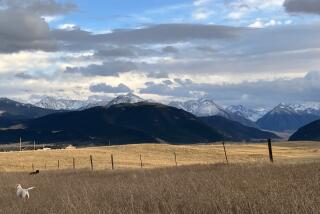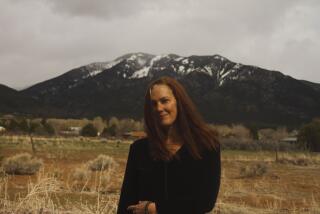Tracking Wallace Stegner’s footprints in Vermont’s earth
- Share via
Greensboro, Vt. — — Wallace Stegner wrote books about the American and Canadian West, so it’s understandable that people consider the longtime California resident a Western author.
Stegner, a prolific novelist, essayist, conservation advocate and professor at Stanford University, was born in 1909 in Iowa and grew up in Utah and Saskatchewan, Canada. Today he is chiefly remembered for his fictional portraits of steely homesteaders and his musings on the American wilderness.
But Stegner lived in Vermont most summers from the late 1930s until his death in 1993, and he considered the small Vermont village of Greensboro his home away from home. Two of his novels concern fictionalized versions of people he knew here, and some of his best-known Western works, including the 1972 Pulitzer-winning “Angle of Repose,” were written partly in his Greensboro study.
“For some writers, it’s easier to particularize a place at a remove,” said Jay Parini, a Vermont poet, novelist and literary critic who has written biographies of Robert Frost, John Steinbeck and William Faulkner. Vermont, Parini told me, was Stegner’s “emotional base” for his Western imagination.
I was drinking coffee with Parini on a sunny July morning in Middlebury, a college town in central Vermont about 300 miles north of New York City and half that distance south of Montreal. I had traveled here to begin my exploration of Stegner’s Eastern literary legacy.
Middlebury was an appropriate first stop because it had a formative effect on Stegner’s early career. Every August, Middlebury College hosts the nationally known Bread Loaf Writers’ Conference at its nearby mountain campus. Stegner first attended it in 1938, and Steg-
ner biographer Jackson J. Benson says the writer’s early experiences here helped him to develop confidence and hone his literary voice.
Bread Loaf was a major change of scene for the young Stegner. As a precocious teenager, he had attended the University of Utah while working odd jobs and covering amateur sports for a local newspaper. It wasn’t until Stegner was earning graduate degrees at the University of Iowa in the early 1930s that he began to imagine himself attending Bread Loaf and hobnobbing with Ivy League literati.
Stegner’s initial application to Bread Loaf was rejected, but he later spent eight summers strolling its meadows and talking books with such writers as Eudora Welty, Truman Capote and Vermont poet Robert Frost, who lived in the nearby village of Ripton. As Steg-
ner later recalled, the days were filled with lectures and manuscript swaps, the evenings with bourbon and laughter.
Frost was known as a curmudgeon, but he liked Stegner, and, according to Benson, it’s likely that the younger writer’s encounters with Frost suffused Vermont with a “special glow” in his mind. Stegner also took the title for his novel “Fire and Ice” (1941) from an eponymous Frost poem; his novel “Crossing to Safety” (1987) riffs on a line in the Frost poem “I Could Give All to Time”: “But why declare / The things forbidden that while the Customs slept / I have crossed to Safety with?”
If Ripton was Frost’s Vermont muse, Greensboro was Stegner’s. Starting in the late 1930s, Stegner and his wife, Mary, drove cross-country nearly every summer in a station wagon packed with books, dishes and a typewriter and stayed in their weathered Greensboro farmhouse until early autumn, when teaching commitments typically pulled Stegner back to the foothills of Palo Alto.
Such tranquillity
Greensboro, about 90 miles northeast of Middlebury and a stone’s throw from the Canadian border, lies deep in Vermont’s Northeast Kingdom, an impoverished area that has partly eluded the waves of gentrification that have swept Vermont. In the 1930s, the village no doubt appealed to Stegner’s Frost-inspired vision of an ideal American town: a place where honesty is king and ordinary people make do in the face of hardship.
Stegner also liked Greensboro for its palpable sense of community. “I grew up without history and without the sense of belonging to anything,” he wrote in the preface to the town’s 1990 history. “From the first day I saw it, I responded to Greensboro because it had what I lacked and wanted: permanence, tranquillity, traditional and customary acceptances, a stable and neighborly social order.”
As I drove to Greensboro from central Vermont on the radiant July morning, the landscape was a fusion of no-frills Americana and urban-tinged sophistication. Two miles after passing a sign that said “We Buy Used Guns,” I ducked into a café that displayed posters for contemporary art exhibitions.
Around lunchtime, I turned onto a narrow country road and followed its whims for about 20 minutes until I hit the Greensboro town line. As I rolled down the town’s main street, I noticed that half the cars outside the Willey’s Store — an iconically Vermonty, white-clapboard affair — were Volvos with out-of-state plates. But I also saw pickup trucks hauling motorboats and flatbed trailers and a sign near Willey’s window that advertised night crawlers and fishing licenses.
At Willey’s, I bought pasta salad and a perfectly ripe peach, then walked toward the nearby village green. As a man crossed the street holding a crisp New York Times, a woman and her children sat down in the grass and unwrapped sandwiches.
As I sat down near them, I checked my iPhone. No service. Aside from the cars, clothing styles and names of the people in the newspaper headlines, I thought, it might as well be 1955.
After lunch, I walked to the headquarters of the Greensboro Historical Society and asked to see the Stegner archive.
There isn’t one, exactly, said Wilhelmina Smith, the society’s vice president. But she did have a file full of Stegner press clippings. Did I want to take a look?
In the basement, I spent an hour browsing Stegner-related articles and obituaries. A portrait emerged of a writer who, though he founded Stanford University’s creative writing program and won both a Pulitzer and a National Book Award (1977), never earned as much mainstream recognition as he felt he deserved.
But Greensboro residents have known of Stegner since at least 1947, when his novel “Second Growth” presented a thinly veiled study of several local townsfolk. It fueled local gossip and led to “charges of scandalmongering and disloyalty,” Stegner biographer Benson said. Amid the ensuing controversy, Stegner wondered whether he and Mary would ever return.
But they did, and, according to Benson, as social discontent swept the country in the 1960s, Stegner began to think of Vermont as an antidote to the “twin threats of hippie and developer” that he feared would overtake the rest of America. He later said he didn’t want his authorized biography written until his ashes were “spread over a Vermont hillside.”
Reading two of Stegner’s novels from the ‘60s and ‘70s, “Angle of Repose” and “All the Little Live Things,” I don’t see clear references to his Vermont summers. But Stegner’s final novel, “Crossing to Safety” (1987), suggests that Greensboro, and the people he met here, left lasting impressions on him.
“Crossing to Safety” relates the tale of two couples who summer in a Vermont town that closely resembles Stegner’s summer haunt. The four main characters are variations on Wallace, his wife and their lifelong friends Phil and Peg Gray. Stegner published the book after the Grays’ deaths, but not before each of their nine children approved the manuscript.
The book doesn’t have a strong plot, but it is a moving study of how love and friendship evolve with age, time and distance. Its power derives partly from its keen attention to landscape: As the years pass and Stegner’s characters change, Vermont serves as their physical and emotional anchor, drawing them back to familiar habits and pleasures — a walk in the woods, a swim in the pond — while underscoring their mortality.
“Over on the western slope of the hill was a place where the ice had gouged a long trough through an outcropping of schist,” Steg-
ner’s narrator observes toward the end of the book. “What was left when the ice withdrew was a bench a hundred feet long, with a sloping back and moss cushions, where at least a dozen times we have gone to be quiet and watch the fire die out of the sky.”
Into the green
At the Greensboro Historical Society, Smith told me that several Vermont landmarks Stegner, an unabashed realist, referenced in “Crossing to Safety” are easy to find in real life. She showed me a topographical map and outlined a suggested itinerary.
I hopped into my car and set off according to her instructions. After stopping at Caspian Lake — which appears in the novel as Battell Pond — I drove down an unpaved dead-end road near a neighborhood that was probably the setting for most of the novel’s action.
Halfway up the road, I killed the ignition and stepped outside. Judging by out-of-state plates in the driveways, most of the homes belonged to summer residents. Although they were upscale, the homes had the rustic touches you wouldn’t find in Malibu or Miami Beach: faded shingles, rusty barbecues, orphaned canoe oars.
I drove on, toward Town Highway 8, also unpaved, in search of the trail where two of the novel’s main characters take an emotionally charged walk. I drove for about 15 minutes, parked and set off on foot in what appeared to be the right direction.
The woods were lovely and deep, and I didn’t see any people or houses. Soon I was turning down a trail I hadn’t expected to find and disregarding the map. When the pond I’d been searching for didn’t materialize, I started to doubt it would.
When I reached a no-trespassing sign, I turned on my heels and started back toward the car. I wasn’t disappointed I hadn’t reached my destination; I’d already gotten a rough feel for Steg-
ner’s Vermont, and I didn’t want to explore Greensboro any further at the risk of acting unneighborly.
travel@latimes.com
More to Read
Sign up for The Wild
We’ll help you find the best places to hike, bike and run, as well as the perfect silent spots for meditation and yoga.
You may occasionally receive promotional content from the Los Angeles Times.






